Tales of Symphonia is There an Easy Mode
| Tales of Symphonia | |
|---|---|
| |
| Information | |
| Game Systems | •Nintendo Gamecube •PlayStation 2 •PlayStation 3 •Windows PC (via Steam) |
| Developers | Namco Tales Studio |
| Publishers | JP GCN Namco NA GCN Namco Hometek EU GCN Nintendo AU GCN Nintendo PS2 Namco |
| Character Designers | •Kousuke Fujishima •Daigo Okumura |
| Composers | •Motoi Sakuraba •Shinji Tamura •Takeshi Arai |
| Animators | Production I.G |
| Japanese Releases | GCN August 29, 2003 PS2 September 22, 2004 PS3 October 10, 2013 |
| North American Releases | GCN July 13, 2004 PS3 February 25, 2014 PC February 2, 2016 |
| European Releases | GCN November 19, 2004 PS3 February 28, 2014 PC February 2, 2016 |
| Opening Theme | GCN "Starry Heavens" by Day After Tomorrow PS2 "Soshite Boku ni Dekiru Koto" by Day After Tomorrow |
| Ratings | JP GCN CERO: FREE (all ages) NA GCN ESRB: T (Teen, recommended 13+) EU GCN PEGI: 12+ DE GCN USK: 6 (restricted below 6) AU GCN OFLC: PG (recommended 15+) JP PS3 CERO: B (recommended 12+) NA PS3 ESRB: T (Teen, recommended 13+) EU PS3 PEGI: 12+ AU PS3 OFLC: PG (recommended 15+) |
Tales of Symphonia (テイルズ オブ シンフォニア , Teiruzu obu Shinfonia ? ) is the fifth main game in the Tales series and the eleventh game released in total. It is also the third game to be released in North America. It follows the adventures of Lloyd Irving as he and his friends work to help Colette Brunel regenerate the world. This title brought the Tales series a new battle system in 3D, in which the player-controlled character moves on a 2D plane, except when physically attacking an enemy located off the plane. It is also the first title in the Tales series to feature alternate costumes for the main protagonists. The game's characteristic genre translates to "'Resonating With You RPG" (君と響きあうRPG , Kimi to hibikiau RPG ? ).
Story
The game begins in the world of Sylvarant, a land that is dying due to a steady loss of mana, an energy source that is needed both for magic and to support life itself. As crops begin to wither and hardship sets in, the people turn their hopes to the Chosen, a servant and messiah of the Goddess Martel, who can reverse the ills of the world by completing the Journey of World Regeneration. In order to regenerate the world, the Chosen must travel from continent to continent, awakening the Summon Spirits that sleep at ancient shrines known as "seals." With every seal released, the Chosen comes closer and closer to becoming an angel. Once the Chosen fully transforms into an angel, the world will be regenerated.
As the game progresses, many revelations are made about the World Regeneration journey. One of the earliest revelations is that becoming an angel forces the Chosen to gradually give up aspects that make him or her human. With the release of the first seal, the Chosen loses the need to eat; with the second, the ability to sleep; with the third, the ability to feel physical sensations; and after releasing the fourth seal, the Chosen can no longer speak. The fifth and final seal requires the Chosen to give up his or her heart, memory, and life. When this process has been completed, the Chosen's body will become one with the goddess Martel.
The party also learns of a second world known as Tethe'alla, which lies parallel to Sylvarant. Replenishing Sylvarant's supply of mana reverses the flow of mana, thereby draining it from Tethe'alla. The reverse also holds true. As the worlds of Sylvarant and Tethe'alla must compete for a limited amount of mana to survive, whenever one of these two worlds is regenerated, the other falls into decline. The party succeeds in releasing all of the seals, and Colette becomes Martel's vessel. However, they learn that the angels they serve have been using them. The party is betrayed by one of its own members, Kratos Aurion, who is then revealed to be a high-ranking member of Cruxis sent to ensure that Colette finished her journey. The remaining party then goes to Tethe'alla to find answers, where their goal ultimately changes to saving the two worlds.
In order to do this, they decide that they must sever the ties between Sylvarant and Tethe'alla to separate the worlds, thus ending the competition for mana. To this end, the party begins making pacts with all of the Summon Spirits of both worlds, but this causes a giant tree to rampage and destroy many things in Sylvarant, including the city of Palmacosta. After they manage to stop the tree, the party searches for a way to fuse the two worlds into one. Ultimately, this means destroying Yggdrasill and making a pact with the Summon Spirit Origin in order to wield the Eternal Sword.
In the end, the party fuses both worlds into one, but a new problem surfaces: the ancient World Tree cannot exist without the Great Seed. In the end, Lloyd and Colette revive the ancient tree of ever-flowing mana and with the aid of the Eternal Sword, merge the two worlds into one. A spirit calling itself Mana, who is the goddess Martel and the spirits of all the people whose lives were lost as a result of the world's severance, appears before Lloyd and explains the complications of the tree to him. Lloyd swears to protect the tree and names it. He then goes off on a journey to collect the remaining Exspheres with whomever his closest friend is by the end of the game, depending on the player's actions. If his closest friend is female, he eventually enters a romantic relationship with that companion.
Characters
- Lloyd Irving (ロイド・アーヴィング , Roido Aavingu ? ) - Once but a simple country boy, Lloyd is thrust out into a journey of epic proportions following a brutal attack on his village. The Chosen of Regeneration, Colette, is in fact one of his dearest friends, and after an exile from his home, Lloyd joins her on her Journey of Regeneration. Although the young warrior himself plays no part in the prophecy as such, he is still a strong optimist and eventually a fair leader.
- Colette Brunel (コレット・ブルーネル , Koretto Buruuneru ? , "Collet Brunel") - The kind and selfless Chosen of Regeneration from the land of Sylvarant, whose destiny is to climb the Tower of Salvation and restore life to the planet. For the sake of this cause, she would willingly give up her own life. She strongly believes in the Goddess Martel and wishes for the worlds of Sylvarant and Tethe'alla to be at peace.
- Genis Sage (ジーニアス・セイジ , Jiiniasu Seiji ? , "Genius Sage") - A childhood friend of Lloyd who grew up studying magic in the small countryside village of Iselia. Being something of a prodigy with his powers, this young boy becomes an invaluable member of the Chosen's group through their Journey of Regeneration.
- Raine Sage (リフィル・セイジ , Rifiru Seiji ? , "Refill Sage") - A skilled healer who worked as a teacher in Iselia before leaving with Colette on the Journey of Regeneration. Together with her younger brother Genis, she claims to be an orphaned elf who carved out a life in the land of Sylvarant.
- Kratos Aurion (クラトス・アウリオン , Kuratosu Aurion ? ) - A sword-wielding mercenary whom the Church of Martel hires in order to protect the Chosen on her Journey of Regeneration. At the beginning of the story, not much is known about this mysterious character, but as things progress, more and more of his history becomes clear.
- Sheena Fujibayashi (藤林 しいな , Fujibayashi Shiina ? , "Fujibayashi Shihna") - A female ninja from the Tethe'alla village of Mizuho who was sent to Sylvarant to assassinate Colette. However, as she travels through the faraway land, she begins to feel sympathy for its people and their plight.
- Zelos Wilder (ゼロス・ワイルダー , Zerosu Wairuda ? ) - The Chosen of Mana from the land of Tethe'alla. Raised as an aristocrat in Meltokio, his view of the world is clouded. He is unaware of the effects of discrimination in his world, although he is aware of its presence. An irrepressible flirt, he takes every chance he can get to hit on all female party members, much to the annoyance of the party. Although he boldly displays an extroverted personality, he does not share his inner thoughts to others.
- Presea Combatir (プレセア・コンバティール , Puresea Conbatiiru ? ) - A young girl who is a victim to the effects of a special Exsphere, halting her physical growth. She is very quiet and constantly asserts her need to go home, but when she regains her true self, she slowly begins to act more human.
- Regal Bryant (リーガル・ブライアン , Riigaru Buraian ? , "Regal Bryan") - A convict bound with shackles for a crime he committed long ago, this man owes no real debt to society for what he did, yet he is unable to forgive himself. The party first meets Regal in the Meltokio sewers, and he seems to know Presea from somewhere.
- Mithos (ミトス , Mitosu ? , "Mitos") - A young half-elf outcast from Ozette, he befriends the party after Cruxis destroys the village. Being so close to Genis's age, they quickly bond. The party shows Mithos that it is possible for humans and half-elves to work together. He is named after Mithos the Hero.
Gameplay
Like previous games in the Tales series, Tales of Symphonia uses a version of the Linear Motion Battle System: a real-time battle system, called Multi-Line Linear Motion Battle System. When the party is on the world map, they can enter battles by running into monsters visible on the field. During battle, up to four players may each control one character. Characters not under the control of a player are controlled by artificial intelligence, and can be set to operate according to specific tactics; players can determine which techniques or magic spells the character may use during battle. AI-controlled choices can be overridden by the player by selecting orders from a menu.
The player may also map certain techniques, spells, or strategies to controller buttons, allowing quick use of them without pausing. Battle movement is relative to enemy characters. Each character and its targeted enemy define a plane perpendicular to the ground, to which movement is restricted. Characters can attack, defend, or use magic and special techniques. Guarding is of much greater importance than in previous Tales games, as Tales of Symphonia characters take more damage when unguarded than their series counterparts, and guarding prevents attacks from stunning the character. However, being hit from behind while guarding triggers a "Guard Break," leaving the character briefly vulnerable.
Another feature of the Multi-Line Linear Motion Battle System is Over Limit. Characters enter Over Limit mode after having obtained a certain number of tension points. Several things contribute to tension, such as getting hit or cooking a meal featuring an ingredient that the character enjoys. However, a character's tension points reset upon dying. Over Limit mode prevents staggering, reduces the amount of damage taken by half, and shorten the casting time of spell. Some attacks may only be used while in Over Limit mode. For example, the character Sheena Fujibayashi must be in Over Limit mode to summon a Summon Spirit. Certain enemies, most notably bosses, can go into Overlimit as well.
Dealing combos on an enemy fills the Unison Gauge. When filled completely, a Unison Attack can be triggered. During a Unison Attack, the player hits buttons corresponding to the position of each character in the party. Each party member executes the move assigned to the top of their list. Certain attacks, when combined together, result in a special attack to cause additional damage. Lloyd, Colette, and Genis Sage also possess special hidden moves that can be activated under specific conditions. The PlayStation 2 version contains hidden moves for additional characters, including some bosses and every member of the party. Grade is awarded after each battle. It is awarded or subtracted based on specific criteria that are fulfilled in battle. Scoring multi-hit combos increases Grade, but having a character die will subtract from it. The length of the battle also has an effect. Grade can be used to purchase items for customization and EX Gems, or to buy bonuses when starting a New Game Plus.
Ports
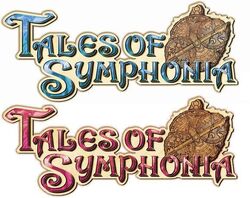
Alternate logos for the game.
Tales of Symphonia (PS2)
Due to poorer-than-expected GameCube sales of Tales of Symphonia in Japan, Namco decided to re-release the game on the PlayStation 2.
Changes
Major
- The Tales of Symphonia logo is magenta-colored instead of blue.
- The PlayStation 2 version functions on one disc instead of two.
- The game's theme song was changed from "Starry Heavens" to "Soshite Boku ni Dekiru Koto", which sounds similar to the original and is performed by the same band, Day After Tomorrow.
- New animated sequences play inside of the Triet Ruins when Colette first receives her wings and when the group first steals Rheairds from the Sylvarant Base.
- Each playable character, as well as some enemies, has a mystic arte. This must be done under special conditions and inflicts massive damage to the enemy. In the GameCube version, only Lloyd, Colette, and Genis have one.
- The end credits now feature a montage of portraits to the left side.
Graphical
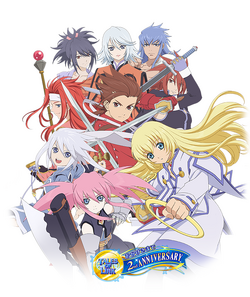
Artwork of the game's cast for Tales of Link.
- The frame rate was lowered from 60 frames per second to 30 frames per second.
- Each character received an extra costume, depending on whom Lloyd chooses in Flanoir.
- Loading times were increased to compensate for the PlayStation 2's poorer graphics engine.
- The "Synopsis" option in the menu displays newer entries at the top.
- The skit portraits shake and move around more to better display the characters' emotions.
- When a character is about to enter Over Limit, their portrait will start to glow. In the GameCube version, the characters flash red.
- When the Unison Attack gauge fills up, it glows.
- Most of the angels' wings became a deeper color.
- The GameCube object in the Sylvarant Base was removed and replaced by the Sony logo.
- The Sword Dancer appears on the field as a regular white skull.
- When Sheena summons a spirit, a cut-in of her face appears on the screen.
- There are more post-battle animations.
- The dark rooms in the Temple of Lightning went from slightly visible to pitch-black.
Events
- There are several books about Mithos the Hero, which can be read for deeper insight into the character and the Kharlan War itself.
- There are two new events that will allow the player to gain more insight into the ancient hero Mithos. The first can be watched by talking to Mithos while he is living in Altessa's House, and the second can be watched by speaking with Yuan Ka-Fai after the events in Welgaia.
- After completely restoring Luin, a chat with Pietro can trigger a scene where both he and the village residents thank the group by allowing one of them to become honorary mayor. Whoever takes this role is the player's choice, and whoever out of the group is chosen will gain a point in affection.
- The sealed spirits of young Kratos, Yuan, and Mithos can be challenged in the Underworld instead of the Living Armor of the GameCube edition. Additionally, three of the five Desian Grand Cardinals—Magnius, Forcystus, and Pronyma—can be challenged in the Underworld as well.
Tales of Symphonia Chronicles
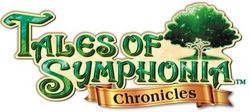
The logo for the Western version of Tales of Symphonia Chronicles .
Tales of Symphonia Chronicles (テイルズ オブ シンフォニア ユニゾナントパック , Teiruzu Obu Shinfonia Unizonantopakku ? , lit. "Tales of Symphonia: Unisonant Pack") is a high-definition remaster for the PlayStation 3 of the PlayStation 2 port of Tales of Symphonia, as well as its sequel, Tales of Symphonia: Dawn of the New World.
Changes
- All three openings are included in the remaster, and each opening song has been remixed.
- The game's international release includes dual-audio.
- Cameo costumes of other Tales characters from Tales of the Abyss, Tales of Vesperia, Tales of Graces ƒ, Tales of Xillia, and Tales of Xillia 2 are included.
- The PAL-exclusive additions were integrated to Tales of Symphonia: Dawn of the New World.
- The graphical presentation of Tales of Symphonia was updated to HD graphics. The textures of all the characters and environments are rendered in a much higher resolution.
- Graphical slowdowns caused by artes were fixed.
- New mystic arte cut-ins are included in Tales of Symphonia.
- Camera angles during cut-scenes in Tales of Symphonia were also changed or added.
Other Installments
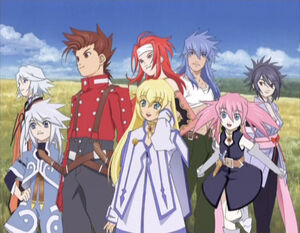
The protagonists of the game.
Manga
Animation
Sequel
Version History
| Game Title | System | Catalog Number | Release Date | Region |
|---|---|---|---|---|
| Tales of Symphonia テイルズ オブ シンフォニア | Nintendo GameCube | DOL-GTOJ-JPN DOL-S-MGOTO DOL-GQSE-USA DOL-GQSP-UKV DOL-GQSD-NOE DOL-GQSF-FRA DOL-S-MGOTO DOL-GQSP-ESP DOL-GQSP-ITA DOL-GQSP-HOL ? DOL-GQSE-USA | August 29, 2003 August 29, 2003 July 13, 2004 November 19, 2004 November 19, 2004 November 19, 2004 November 19, 2004 November 19, 2004 November 19, 2004 November 19, 2004 November 23, 2004 2005 | Japan Japan ("Plus Pack") North America United Kingdom/Sweeden/Denmark Germany France France ("Limited Edition Pak") Spain Italy Holland Australia North America ("Player's Choice") |
| Tales of Symphonia テイルズ オブ シンフォニア | PlayStation 2 | SCAJ-20102 SLPS-25400 SLPS-73217 | September 22, 2004 September 22, 2004 July 7, 2005 | Asia Japan Japan ("PlayStation 2 the Best") |
| Tales of Symphonia Chronicles テイルズオブシンフォニア ユニゾナントパック Tales of Symphonia: Unisonant Pack | PlayStation 3 | BLJS-10231 BLJS-10231 BLJS-10231 BLAS-50653 BLAS-50653 BLUS-31172 BLUS-31172 BLES-01864 BLES-01864 ? | October 10, 2013 October 10, 2013 October 10, 2013 October 10, 2013 October 10, 2013 February 25, 2014 February 25, 2014 February 28, 2014 February 28, 2014 February 28, 2014 | Japan Japan ("LaLaBit Market Limited Edition") Japan ("Famitsu DX Pack") Asia Asia ("LaLaBit Market Limited Edition") North America North America ("Collector's Edition") Europe Europe ("Collector's Edition") Australia |
| Tales of Symphonia テイルズ オブ シンフォニア | Microsoft Windows (Steam) | - | February 2, 2016 | Worldwide |
Trivia
- Tales of Symphonia takes place several thousands of years before the events of Tales of Phantasia, set in the combined worlds of Sylvarant and Tethe'alla, known by this point as the world of Aselia. The exact distance of time between the two games is unstated.
- This game, like all Tales games, contains constant mythology references in it. The world and myths of Symphonia are primarily based around Norse mythology with elements of Roman Catholicism. Mithos Yggdrasill's name is taken from Yggdrasil, the world tree that was believed by the Norse to support and nourish the world; this concept of a world tree is manifested in the Great Kharlan Tree. Norse mythology also inspired the names of Asgard, Heimdall, Ymir, the underworld Niflheim. The appearance of Norse mythological creatures, such as elves and dwarves, further demonstrate the game's connection to Norse mythology.
- Themes include Pagan elements, which are evident in the concept of the goddess Martel and the general nature themes present in the game. The universal themes of death and renewal, and/or reincarnation can be seen in the seesawing parallel worlds; as well in the Chosen ritual. This theme is also specifically mentioned during one encounter with a unicorn. Typical high fantasy elements are abound in the game as well, such as dwarves and elves. There are also elements from the Bible: the Seraphim came from the angel caste system, and the theme of achieving salvation is espoused by the Church of Martel. In a book that Genis keeps in his room, humans who have turned to the side of the Desians are known as the "Fallen", which is a reference to the dual views of good and evil as taught in Christianity.
- The story carries the reappearing motif of facing discrimination and racism. Half-elves are distrusted and despised by humans and elves in both Sylvarant and Tethe'alla. In Tethe'alla, half-elves are considered to be inferior and are at the bottom of the caste system; while in Sylvarant, a group known as the Desians, who wreak havoc upon the world, make up the majority of the half-elves there. This leads to a cycle in which humans persecute half-elves due to their hatred for the Desians, and the half-elves join the Desians in their mutual hatred, as well as to escape persecution.
Gallery
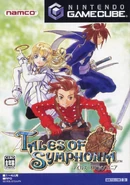
Cover for the Japanese GameCube version of the game.
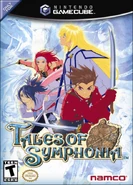
Cover for the North American GameCube version of the game.
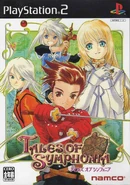
Cover for the Japanese PlayStation 2 version of the game.
External Links
caldwellbastoofter.blogspot.com
Source: https://aselia.fandom.com/wiki/Tales_of_Symphonia


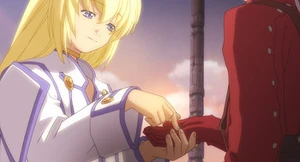



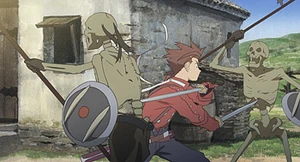

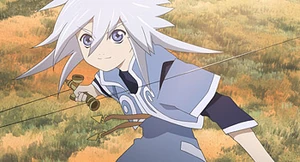

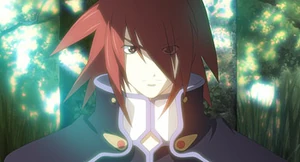


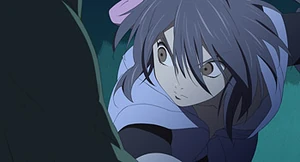

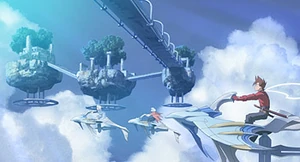





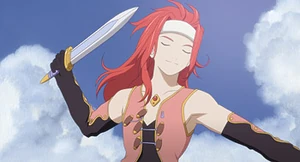
0 Response to "Tales of Symphonia is There an Easy Mode"
Post a Comment